Right now is a pivotal time for Japanese makers. Policies like the US Inflation Reduction Act and the CHIPS Act are forcing corporations to diversify their supply chains for reliability and to reduce country risks, with nations such as China. Japan is known for its reliability, advanced technology, and a weak JPY, so for the time being Japan has never been a more cost-effective option. This means that Japanese firms have an opportunity to expand their existing global market shares. Do you agree with this sentiment, and in your opinion, what do you believe to be the advantages of Japanese companies in this current macroeconomic environment?
I agree with that sentiment. In addition, I believe that Japanese companies have two major strengths:
-High level of quality and delivery management
-Continuous and independent improvement
Japan is known worldwide for its aging population, and experts are now predicting that by 2050 the population of Japan will dip below 100 million due to low birth rates. This has created a labor crisis as well as a shrinking domestic market. From your perspective, what have been some of the challenges and opportunities you’ve seen as a result of this demographic shift, and how are you reacting to these changes?
The shrinking population is posing a grave danger to our production in particular. We have our factories placed around the Nagano area, and rural areas like Nagano are the ones that are hit the worst when it comes to this sharp decline in population. Securing a labor force is becoming more and more difficult so we are trying to introduce more automation and robotics to increase efficiency in production while at the same time expanding overseas.
It is true that, as Japan’s population and industry continue to shrink over the medium to long term, overseas expansion is essential for corporate growth. Therefore, we are proceeding with the transfer of some of the production to overseas bases. Originally, we have made it possible to perform product maintenance at any of our overseas bases. In addition, in Korea and Taiwan, we are preparing personnel and facilities to enable the production of major models.
As the semiconductor industry aims to become a USD 1 trillion industry by the end of the decade, experts believe that the demand for newer technology such as 5G, AI, and cloud services is going to be among the key driving forces for growth in this market. As such, the role of vacuum pumps and precision machinery will play a vital role. With this in mind, how do you foresee the next 12 months playing out for your business and what do you believe will be the main growth drivers going forward for your company?
Compared to 2023, we think we can expect sales to increase by 10-15%. The reason for this is an increase in semiconductor-related investment. Inventory adjustments for semiconductors and their production equipment have progressed, and customers are now ready to invest in factories and equipment. It is expected that the market will continue to grow at the same level over the next 2 to 3 years, and we believe that we can grow accordingly.
Your business is part of the fabrication equipment business, which itself is very cyclical and depends on the demand for foundry capacity increasing or refurbishing. This year is set to be a year of rebounding for the semiconductor industry but what is more interesting is what comes after 2024. All large corporate groups such as TSMC and Samsung are expected to see explosive growth from 2030 and this has been met by investment. Global foundry capacity is set to double within the next decade and 16 new plants are being opened in the United States alone. In the long term, what opportunities does this huge increase in global foundry capacity present for your company and what strategies do you have to leverage on this expected increase?
Expanding our production capacity to meet the needs both domestically and overseas is key for our growth, so we are strengthening our production capacity in our factories in Korea and Taiwan, and at the same time in Japan, we are fortifying our production capabilities as well as refurbishing our maintenance facility so that we can accommodate more requests and increase our capabilities overall.
You said that in Japan you want to expand your production capacity to accommodate more requests, and the Japanese government has made attracting foreign foundries onshore a key part of its agenda. It worked well with TSMC in Kumamoto and other firms have announced their intention to invest in research and production in Japan. Do you expect Japan’s popularity as a production hub to increase in the coming years?
I believe that certain types of semiconductors, particularly power semiconductors, will flourish in Japan. I also expect the expansion of other categories of semiconductors such as memory. In the future there will be increases in the capabilities in semiconductor production, thus we will increase our sales in this field.
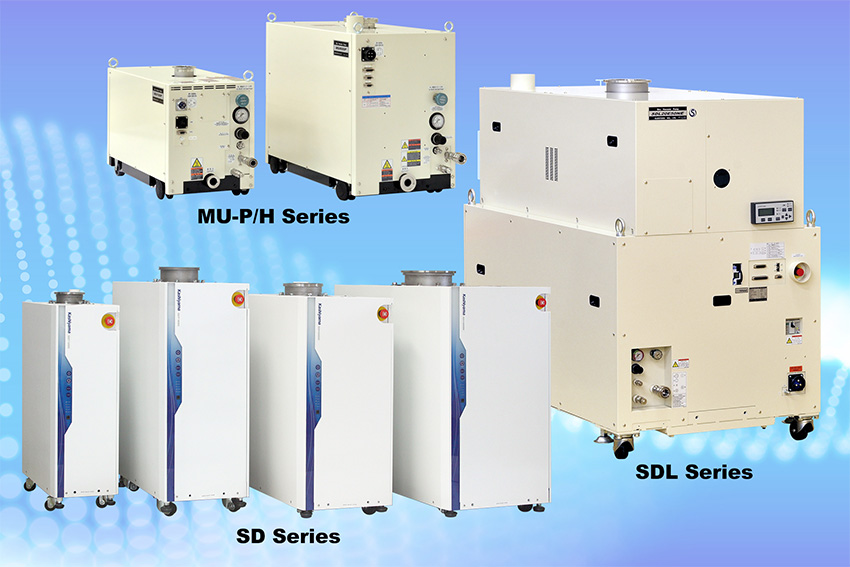
The MU-P/H series excels in energy and space-saving, the SD series refines its performance, and the SDL series is capable of large capacity.
Building new facilities goes hand in hand with carbon neutrality, with Japan aiming for a 46% reduction by 2030 when compared to 2013 emission levels. Your products leave a very small carbon footprint. Can you elaborate on how Kashiyama’s products and initiatives are contributing to reductions in carbon footprints?
Our product strengths lie in our environmental friendliness. The recently released SD Series for example is known for its energy-saving ability compared to the previous series and has achieved top-level space-saving in the 20,000L/min pumping speed class. We have also launched the MU Series which boasts energy-saving and space-saving features, and SDL Series for large pumping speed. The advantage of our products’ compact size is that they require fewer pipes and wires for connections which overall is contributing to a decrease in carbon footprints.
On top of your vacuum solutions, you are also supporting ski-resort operations for both equipment and management consulting. Which of your business divisions has the most growth potential from a business point of view?
Our ski business was initiated by my father who is the chairman. There was a request from a local ski resort for a snow machine since they have been using a costly overseas-produced one. This was the starting point for our business in this sector. In recent years, semiconductor vacuum solutions have become the core of our business. The growth of semiconductors is expected to double in ten years, so we are expected to double our turnover in this field.
Not only did you develop Japan’s first snow-making system in 1978, but by 1998 you had an 80% market share with adoption particularly picking up because of the Nagano Winter Olympics. What was the triggering point that led to your company diving into this business division?
Near our base is Karuizawa, one of Japan’s leading resort areas. After hearing from a ski resort in Karuizawa that foreign-made snow machines were having trouble, we decided to develop our own. We are now one of the very few companies that can provide snowmaking solutions.
The ski business is more familiar to the local community, and we are very happy that many people have come to know our company through it.
The common thread that runs through the developments of snow machines and vacuum pumps is that we have applied our technology and labor to create new products and value based on customer requests. We still have the same desire to support the development of our customers with the technology and services we have developed.
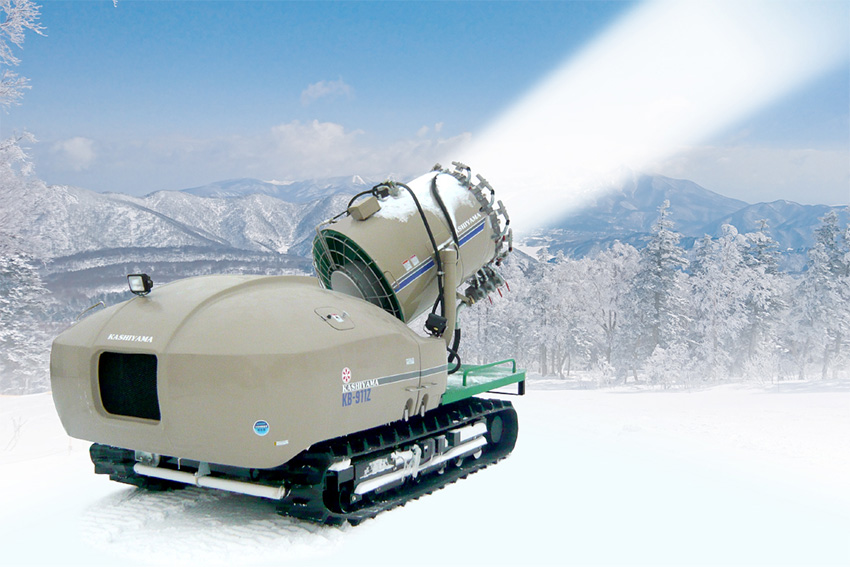
Self-propelled snow machine KB-911Z manufactured by Kashiyama
Your company is providing several solutions for the semiconductor industry and one that stands out in particular is the MU-X Series, a unit that is applicable for various tools. Could you give us a couple of examples of where this pump has been integrated and the advantages the MU-X Series offers in those applications?
Our MU-X Series is often utilized in semiconductor production and semiconductor machinery. The MU-X Series strengths lie in its energy-saving features and multiple options can be combined to adapt to specific equipment. One example is the load lock and the transfer chambers that require a vacuum environment, our pumps are widely used.
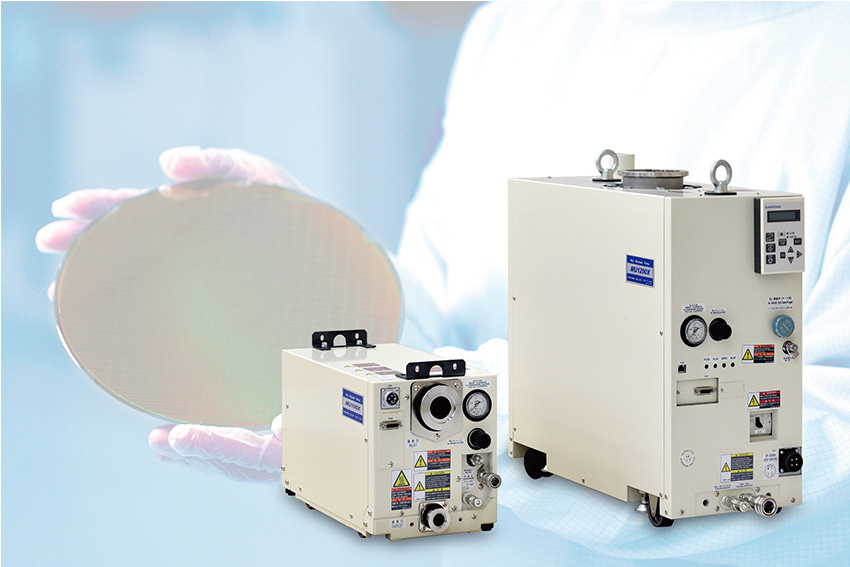
The MU-X series is used in the semiconductor manufacturing sector.
In addition to the MU-X Series, you’ve also developed your NeoDry Series, however, other companies have also developed similar products. How is your product superior to similar products offered by competitors?
The strength of our product is that it doesn’t have any contact points. Some vacuum pumps offered by other companies use chip seals that are in contact constantly. This will wear out little by little, but since we don’t have those chip seals, our unit doesn’t require any exchange.
Our unit is also very quiet, and sometimes it is hard to tell if it is operating at all. To that end, we’ve added an LED lamp to tell operators that it is functioning since it is so quiet. Research centers and laboratories often have several machines running at the same time, meaning it might be so noisy that technicians can’t talk to each other. We wanted to provide an environment where work can be done without the hindrance of noisy machinery.
The NeoDry also has a feature that means it doesn’t require any cooling water. Air is the only requirement for the unit. I think these unique features of the NeoDry help it stand out among the competition. To add to the features, all of our equipment features long life spans. The last model we released is still being used in lab environments eight years later without any signs of slowing down. We wanted the units back but labs are saying that it is working perfectly still. Since the model has no contact points it is basically maintenance free and that is what allows the units to have such long lifespans.
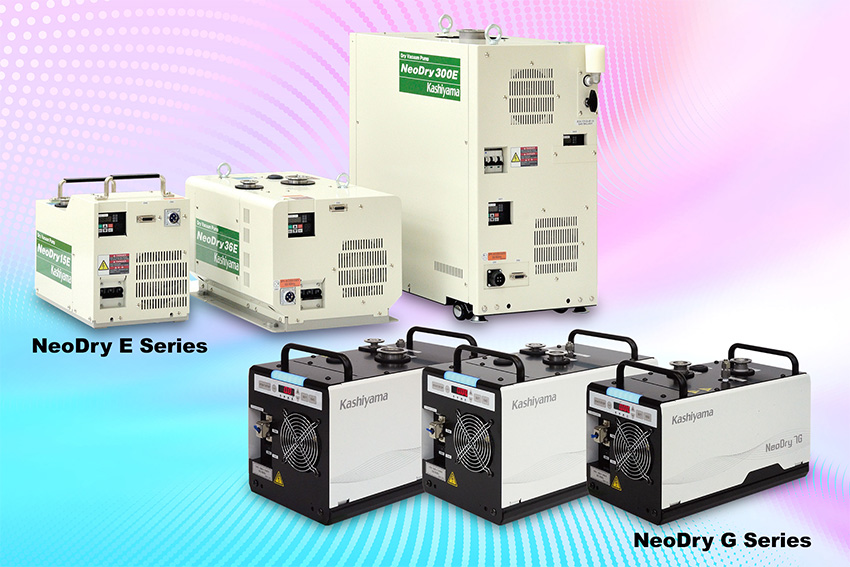
NeoDry series compact air-cooled dry pump.
When we talk about dry vacuum pumps the market is quite competitive in Asia, with some heavy hitters offering their products. How are you able to differentiate Kashiyama’s offerings to face this competition from both large and small players?
The uniqueness of our products is the high-energy saving capabilities. It is top of its class in terms of energy saving. Additionally, there are the long lifespan features I just mentioned. Since little to no maintenance is required, semiconductor companies can avoid the downtime associated with equipment replacement.
Our company has been present in the semiconductor industry for a long time now and we have accumulated a lot of experience working in harsh environments. This has allowed us to offer various options to combine and fit the needs of the customer. I think this combination we offer is how we differentiate ourselves the most among fierce competition.
Today in the semiconductor industry we are seeing an increased trend towards miniaturization. As such there are a series of new materials and processes that are entering foundries as the industry moves towards 3D and 4D integration. If you look at deposition states for example, new technologies such as atomic layer deposition (ALD) are creating a lot of challenges for vacuum and abatement equipment, specifically in terms of corrosion resistance. How are these technological innovations impacting your R&D? What are some of the sectors or applications that you are currently researching to better improve your products?
We are focusing on creating a temperature control system that could cater to different ALD gasses. The ALD process is a harsh process that emits a huge amount of gas in a short period. Being able to control each type of gas through temperature is a new attempt we are trying to make. As a byproduct of ALD there is always a powder product, so figuring out how to emit this powder smoothly is the key to maintaining a high-quality production deposition. We are now introducing a method to take this powder and reduce the size of the particles before it enters the pump and to make it easier for the pump to emit this powder.
When do you expect to produce this product?
Some of it has already been trialed by our customers and our goal is not to provide this complete set to our customers. Instead, we are looking to add these features as customization options.
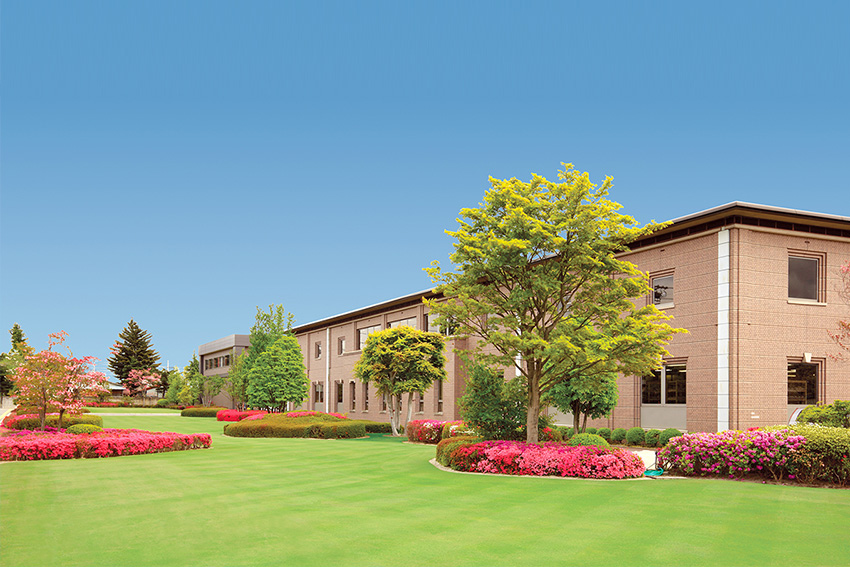
Kashiyama Industries, Ltd. Headquarters.
Your company has several different subsidiaries in China (2003, 2016, 2020), Korea (2006), Taiwan (2007), Vietnam and Germany (2017) and Japan. What advantages do these subsidiaries give to your company and are you looking to further expand through the establishment of more subsidiaries?
As for production enhancement, we are now fortifying our Korean factory and Taiwanese factory. As for maintenance services, we want to strengthen our presence in China and the US, two rapidly growing markets for semiconductor production. Opening up our direct maintenance services to support these areas is important. We are looking into the best locations at this time.
You mentioned various semiconductor markets; Korea and Taiwan are legacy locations, with China and the US being emerging ones. These are far away and huge markets, particularly when we talk about the US and China. Are you looking for partners in these locations, whether that be technical or distribution? If so, what does a partner of choice look like?
We are in constant search for new partners, especially in China and the US where the landmass is massive. We need to find the best partners for sales and customer service to be able to comprehensively cater to the market.
For sales, we are looking for a sales agent to sell our products. As for services, we need a technical provider who can support the installation and maintain our products in our customers’ factories.
Your products have been sold throughout universities as well as semiconductor manufacturers. Looking forward, what applications or industries will you be targeting?
We are catering to different business sectors; from food, to medical, to ski resorts, to even semiconductors. Vacuum pumps are required to provide clean air and sanitation. We are focusing on cutting-edge technologies and scientific discoveries. In Japan, our products are widely used but there is active research being done in the US, Europe, Korea, and China. If we can tap into overseas particle accelerator fields, it would be a great opportunity for our company. We are very hopeful that our products will be adopted in overseas research fields.
You took over the presidency of Kashiyama back in 2018. Looking back at the last six years, what is the thing that you’re most proud of having accomplished? Looking at the future, are there any ambitions that you would like to achieve?
To be completely honest, there isn’t anything particular that sticks out as far as things I’m proud of over the last six years. In fact, all of the pride comes from our employees and their efforts to lead the company. I have only been a small contributor to what this company has achieved throughout its history. As a result of my presidency, however, the company has been able to see growth and expansion not only in size but also in employee headcount. This is a very good sign of where the company could go in the future.
I believe that overseas expansion is essential for “survival” rather than “growth”. Most of the factories of our main customers, semiconductor manufacturers, are located overseas. Our competitors are also expanding widely both domestically and internationally. Staying in Japan will cause gradual shrinkage of market share, sales channels, and crush. For us, going abroad is a necessity for survival.
For more details, explore their website at https://www.kashiyama.com/en/
